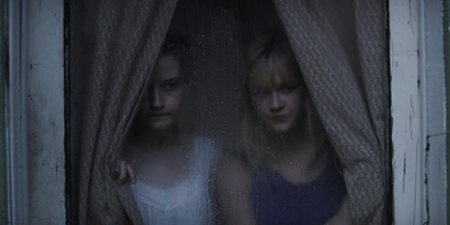By Kim Voynar Voynar@moviecitynews.com
Sundance Review: We Are What We Are
Spoiler alert: This review contains a significant spoiler. If you don’t already know (or want to know) what it’s about, move along.
As heavy rains and flooding hit a small town in the Catskills, a middle-aged woman collapses, spewing up blood, and drowns in a ditch. Thus Jim Mickle’s stunningly shot We Are What We Are, a re-imagining of Mexican director Jorge Michael Grau’s 2010 film of the same name, sets in motion its tale of the Parker family, headed by patriarch Frank (Bill Sage), a fierce, controlling, humorless man who rules over his three children with religious fervor and a devotion to maintaining a macabre family tradition.
Given that this is a reinvention of the earlier film, it’s not really much of a spoiler to say that the Parker’s skeleton in the closet involves the annual ritual “sacrifice” and eating of human flesh. With Mother Parker dead, the burden of prepping the main course for the family’s “Lamb’s Day” dinner passes to Frank’s older daughter, 17-year-old Iris (Ambyr Childers). Iris bravely steps into the role of family matriarch, but her younger sister, 14-year-old Rose (Julia Garner), obedient to her father’s will on the surface, inwardly struggles with wishing their family could just be normal and rebels in subtle ways, sneaking her brother food during the fast and wearing her curly looks unbraided.
Being forced to kill and prep the family’s meal using their mother’s handy-dandy cannibal cookbook forces the two sisters to come to terms with just what their family really is. While much younger brother Rory (Jack Gore) is innocent and blissfully unaware of the family’s ritual of sacrifice as anything other than a holiday that forces him to fast for two days in preparation, their mother’s death forces the girls to face who they really are and what their family history and mythology requires of them. It’s a bit like how it might feel to be a kid coming of age on a rural farm who’s forced for the first time to to slaughter and butcher an animal, rather than having it set on the table already prepared.
Further complicating matters for the Parkers is the torrential downpour that’s causing flooding in and around the town, consequently eroding the ground and unearthing bits and pieces of the family’s secret. The town doctor and medical examiner, Doc Barrow (Michael Parks), whose own young daughter has been missing for some years, uncovers evidence in a creek bed that makes him suspect what may have happened to her, and cross-cutting between the scenes of Lamb’s Day prep and the good doctor getting ever closer to learning the truth effectively build tension as the film progresses. Meanwhile, handsome young deputy Anders (Wyatt Russell) keeps poking around to see the lovely Iris and finds himself drawn into the doctor’s hunt for more evidence, and kind-hearted but nosy neighbor Marge (Kelly McGillis) can’t seem to stop snooping around at inopportune times. With the family’s long-held secret on the verge of undoing everything, Frank, who’s own mental condition isn’t on what you might call solid ground, starts to unravel even more.
In spite of its rather macabre subject matter, We Are What We Are isn’t so much a horror story as it is a coming-of-age tale about these two sisters whose circumstances require them to either accept the role put upon them upbringing, or betray their father and dead mother. It’s gross to be a cannibal, sure, but if that’s all you’ve ever known, and your crazy-ass, controlling father wraps it all up in a neat package of deep paternal love, religious fervor and the belief that the sacrifice of another is necessary to preserve your own life, you might also find it a little complicated to unravel the moral dilemma once you were old enough to question your parents and desire to make your own choices.
There are some terrific performances in this film, most notably from Childers and Garner, who move seamlessly from wide-eyed naivete to fierce protectiveness. And man, is this a gorgeous, well-put together film, with frame after carefully composed frame of black and blue color palette sumptuously filling the screen, light and shadow effectively evoking mood, some nicely literary use of metaphor, and a score that moves things along without being heavy-handed or manipulative. The contrast of the beauty with which the film is shot and its macabre subject matter creates its own sort of tension that quite effectively serves the story.
In some ways, We Are What We Are reminded me a bit of Giorgos Lanthimos’ 2009 twisted family tale Dogtooth; while it doesn’t quite hit that film’s watermark for shocking originality, it does explore similar ideas of what happens when children raised in religious isolation, with bizarre family rules replacing normalcy, the coming-of-age and teenage rebellion of children threatening the domination of the parents. Much as the siblings in Dogtooth were hopelessly warped by their bizarre upbringing, so too have Iris and Rose been shaped by theirs. Tonally different though the two films may be, at their core they say this: There is human nature, and there is human nurture, and the impact of the latter may be the harder of the two to overcome. Understanding this makes the film’s conclusion, which could arguably be said to be a bit of a misstep at odds with the rest of the film, make its own weird kind of sense.

















Nice review. It was very helpful to my research. Thanks and keep up the good work.
This is a well-done review. It is thoughtful and engaging. I especially appreciate your mention of color palette and location, and delving into the overarching theme of the movie–coming of age. Good work.